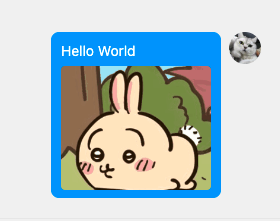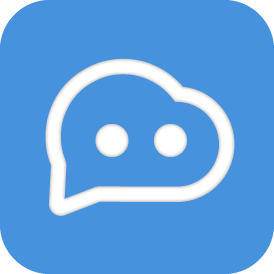Message Platform Entities
Table of Contents
LangBot supports multiple messaging platforms, but the message entity format of each platform is different. To shield these differences, LangBot has a unified standard. Plugin developers only need to master and use the message entities described on this page in their plugins, and LangBot's internal message processing logic can automatically complete the parsing and conversion of messages.
INFO
LangBot's message platform entities are modified based on the implementation of YiriMirai.
Message Chain
The message of a message platform is different from the message used for AI interaction. The message of a message platform is described in the form of a message chain. Each independent message displayed on QQ is a message chain, which can contain multiple message chain components such as text, image, @ component, for example:

This is a message chain, containing one Plain component (Hello World) and one Image component (Usagi)
The definitions of message chain and message chain components are located in pkg/platform/types/messages.py.
Constructing Message Chain
Please import the pkg.platform.types package first to use the message components.
from pkg.platform.types import *
# Build a message containing the text Hello LangBot and an image (from URL)
msg_chain = MessageChain([
Plain("Hello LangBot"),
Image(url='https://qchatgpt.rockchin.top/langbot-logo.png')
])
# Build a message containing @all and the text Hello LangBot
msg_chain = MessageChain([
AtAll(),
Plain("Hello LangBot")
])
# Build a message containing @specific member and the text Hello LangBot
msg_chain = MessageChain([
At(123456),
Plain("Hello LangBot")
])Currently supported message chain components:
SourceSource message chain information, if it is a message received from a message platform, this component will be included at the beginning of the message chain, recording message informationPlainPlain text messageQuoteQuote messageImageImage messageAtAll@all members messageAt@specific member messageVoiceVoice message- Need to check message platform support
ForwardForward message- Not supported on many platforms, not recommended to use
FileFile message
For specific usage, please check the definitions in the source code pkg/platform/types/messages.py.
Message Platform Events
These events are different from LangBot plugin events, they are an independent set of event systems for the message platform system. These events are the source events of LangBot messages, which can be obtained from each Query.message_event.
# For example in a plugin
@handler(GroupMessageReceived)
async def _(self, ctx: EventContext):
# Get the message platform event
message_event = ctx.query.message_eventMessage platform events are defined in pkg/platform/types/events.py.
Other Entities
In addition to the above entities, there are also entities such as Friend and Group, which are defined in pkg/platform/types/entities.py. They are generally included in the above event objects, from which you can get some information not included in the plugin events.
Accessing Message Platform Low-Level API
In order to smooth out the differences between various platforms, LangBot provides an abstraction layer on top of the message platform APIs, namely the content described above and the platform adapters in the pkg/platform/sources directory.
However, due to the large differences between platforms, the entities and API encapsulation in the abstraction layer are not complete. If your plugin needs to access specific platform functions, you can access the low-level API according to the following instructions.
INFO
The adapter here is the instantiated object of each adapter, corresponding to the xxxAdapter(adapter.MessagePlatformAdapter) class in each file under pkg/platform/sources/. It can be obtained from the plugin event's query.adapter, for example:
# For example in a plugin
@handler(GroupMessageReceived)
async def _(self, ctx: EventContext):
# Get the adapter object
adapter = ctx.query.adapter| Platform | Adapter | Access Method | Description |
|---|---|---|---|
| OneBot v11 | aiocqhttp | adapter.bot | The bot object corresponds to the CQHttp object of aiocqhttp, please refer to the aiocqhttp documentation for detailed usage |
| QQ Official API | qqofficial | adapter.bot | The bot object is the SDK object under libs/qq_official_api, for detailed usage, you can refer to the way of initiating HTTP requests in the send_group_text_msg method in QQOfficialClient in libs/qq_official_api/api.py, please check the QQ official API documentation for specific interface documentation |
| WeCom | wecom | adapter.bot | Refer to the way of initiating HTTP requests in the send_image method in WecomClient in libs/wecom_api/api.py, please check the WeCom API documentation for specific interface documentation |
| WeChat Official Account | officialaccount | - | Please refer to the interface documentation information in the WeChat Official Account API documentation, the relevant credential information can be obtained from adapter.bot |
| Feishu | lark | adapter.api_client | Feishu SDK's API Client object, please refer to oapi-sdk-python |
| DingTalk | dingtalk | - | Please refer to the DingTalk API documentation, the relevant credential information can be obtained from adapter.bot |
| Discord | discord | adapter.bot | The bot object is the Discord object of Rapptz/discord.py, please refer to the documentation for detailed usage |
| Telegram | telegram | adapter.bot | The bot object is the Telegram object of python-telegram-bot, please refer to the documentation for detailed usage |
| Slack | slack | adapter.bot | The bot object is the object in libs/slack_api/api.py, please refer to its code and Slack SDK for detailed usage |
